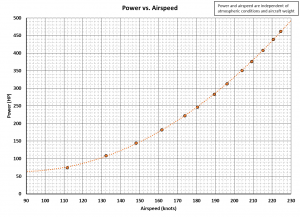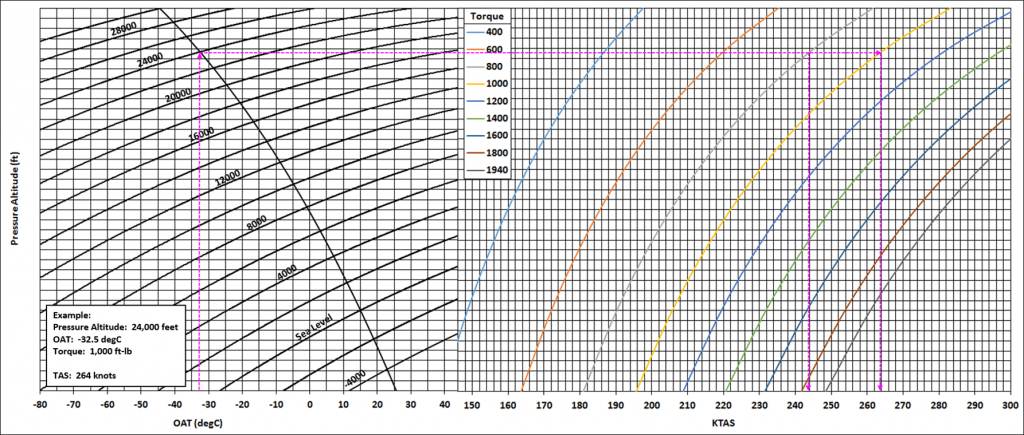Lack of aircraft performance information is a typical issue faced by pilots who choose to operate experimental-amateur built (E-AB) aircraft. Unlike their FAA-certified counterparts, most E-AB aircraft do not have aircraft performance data in the form of tables or charts contained within a Pilot’s Operating Handbook or Airplane Flight Manual. If your E-AB aircraft utilizes an electronic flight display (EFD) which stores flight data you can help us develop performance charts.
How We Did It
We obtained and analyzed flight data from a turbine-powered Lancair Evolution. Since our goal was cruise charts that would benefit the pilot in pre-flight planning, we focused primarily on level flight performance. The goal was to find a relationship between power and true airspeed that a pilot could utilize for planning at all air densities and aircraft weights. The result can be seen in Figure 1. This data made it possible to create a cruise performance chart yielding true airspeed at any user specified atmospheric pressure/temperature and engine torque (Figure 2).
The magenta lines in Figure 2 outline an example performance calculation. The parameters include:
- Pressure Altitude — 24,000
- OAT — minus 32.5
- Torque — 1,000
The computation yields a true airspeed of 264 knots. The data within the chart can also be supplied in a tabular format as shown in Figure 3. The data analysis is currently ongoing. A wider range of flight data will allow for refinement of the cruise table, incorporation of maximum cruise values, and fuel flow. Fuel flow will be connected to true airspeed values based on atmospheric pressure/temperature and engine torque. We are looking for individuals who would be interested in flying a flight test profile and submitting their flight data from their EFD. Any aircraft with electronic flight and engine data are welcome.
How to Collect Data
The flight test profile is as follows:
- Select altitudes for testing [low, medium, high].
- Fly aircraft to selected altitude.
- Fully stabilize aircraft at maximum level flight speed at full throttle and maximum cruise RPM while ensuring aircraft/engine limitations are not exceeded.
- Decrease torque 100 ft-lb. or manifold pressure 1” and allow aircraft to fully stabilize.
- Repeat step 4, if possible, until aircraft is on the back side of the power curve. Obtain two test points on the back side of the power curve by repeating step 4.
- Repeat steps 2 through 5 for the remaining test altitudes.
Ensure your EFD records the following:
- Airspeed – Indicated or Calibrated and True
- Pressure Altitude
- Ambient Temperature
- Record aircraft empty weight, initial fuel quantity, pilot/passenger weight, baggage weight, and any other onboard item weights
- Fuel Quantity
- Fuel Flow
For Turbine Aircraft:
- Torque
- RPM (NP)
- Gas Generator Speed (NG)
- ITT
For Reciprocating Aircraft:
- Manifold Pressure
- RPM
If you are interested in getting involved contact David Saracino at david.saracino [at] avsafe.com or (314) 682-0461 prior to performing the flight test.



